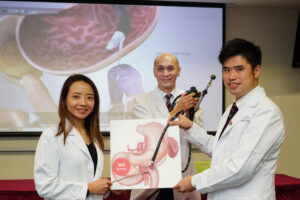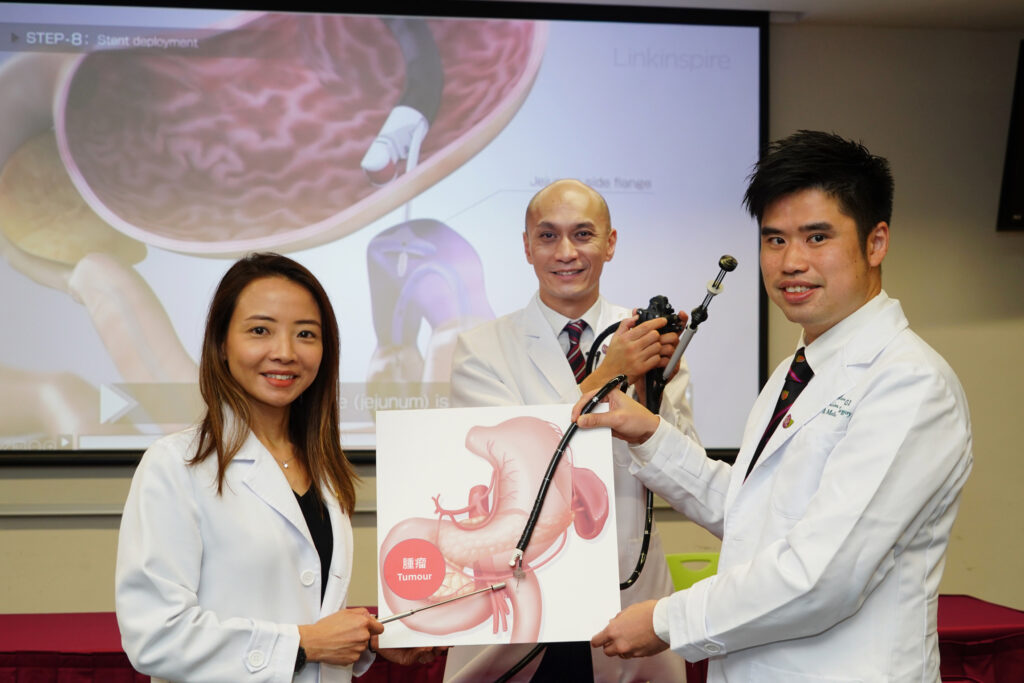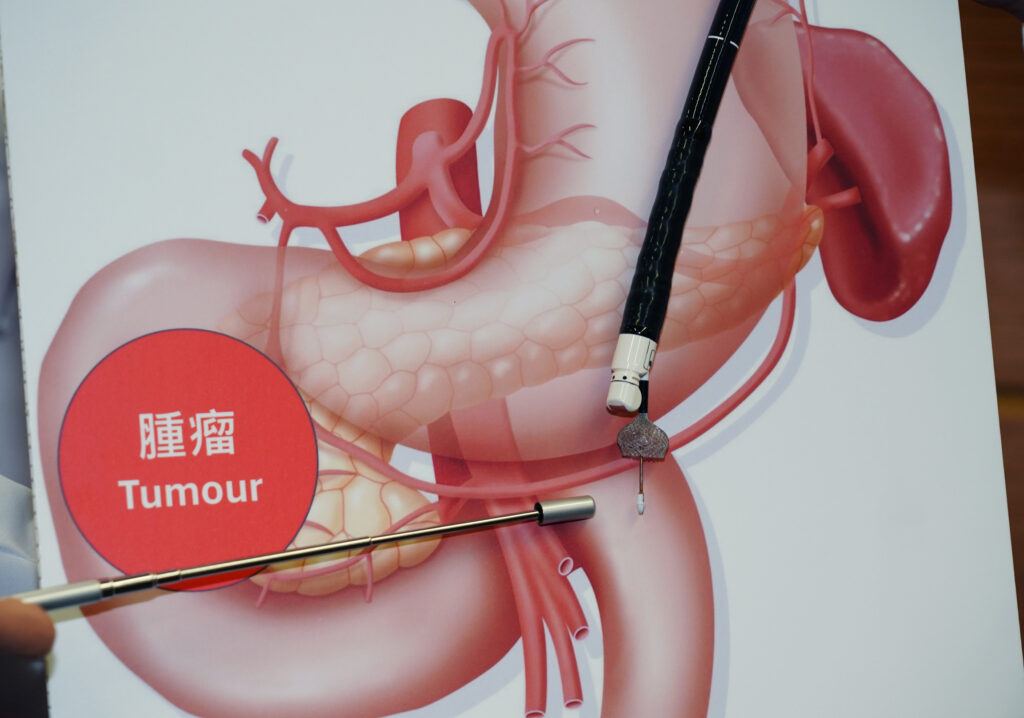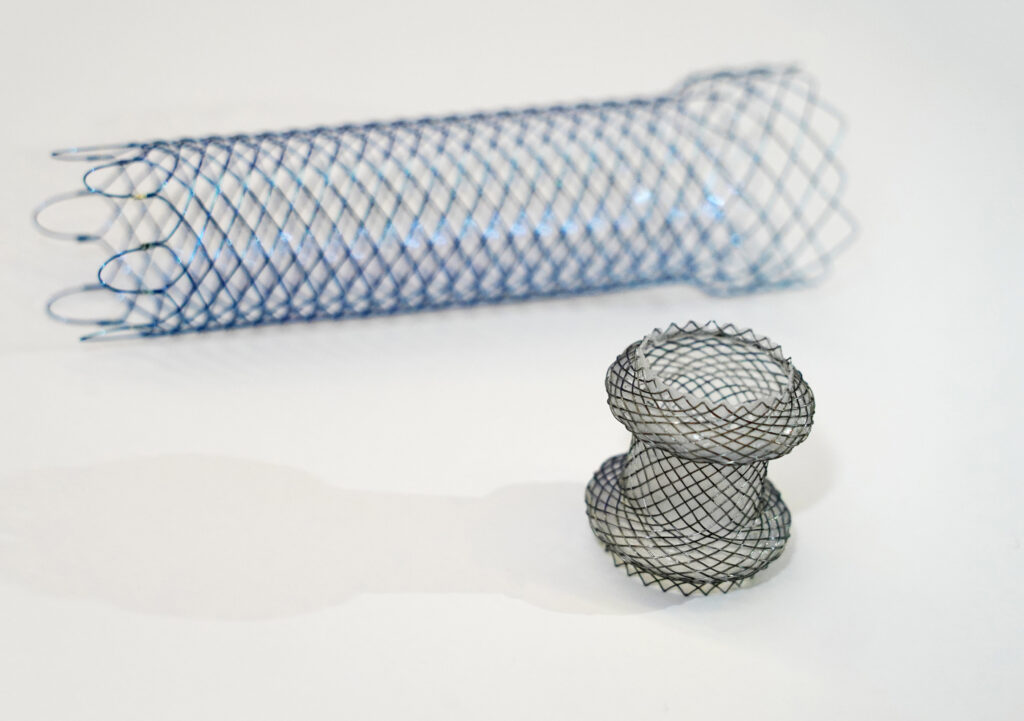CUHK
News Centre
CU Medicine proves a new endoscopic gastrointestinal bypass is superior to conventional treatment
for patients with malignant stomach outlet obstruction
Malignant gastric outlet obstruction (GOO) is a common condition in patients with unresectable advanced stomach, duodenal or pancreatic cancers. The Chinese University of Hong Kong’s (CUHK) Faculty of Medicine (CU Medicine) was the first to introduce endoscopic ultrasound (EUS)-guided gastroenterostomy (EUS-GE), a close-to-non-invasive endoscopic procedure that creates a connection between the stomach and small intestine as a bypass, to treat GOO patients in Hong Kong. A recent multicentre international study conducted by CU Medicine proves that EUS-GE is superior to conventional endoscopic duodenal stenting (DS) in unresectable GOO, with longer stent patency, lower chance of reinterventions, shorter hospital stays and better eating habits. The team suggested EUS-GE is preferable for patients with GOO who have a reasonable life expectancy. Results have been published in the medical journal The Lancet Gastroenterology & Hepatology.
MGOO is a common clinical condition among patients with advanced stomach and duodenal cancers
GOO refers to the obstruction of the outlet of the stomach or duodenum due to tumour compression or infiltration. Patients are not able to eat and may present with symptoms such as repeated vomiting, abdominal distension and severe malnutrition, further compromising overall well-being. The conventional method to palliate GOO is endoscopic insertion of a self-expandable duodenal metal stent across the luminal narrowing or surgical creation of a bypass away from the obstruction, known as gastrojejunostomy. EUS-GE is a procedure similar to surgical bypass but it could be performed without the need of surgical incisions and general anaesthesia.
Dr Yip Hon-chi, Assistant Professor in the Department of Surgery at CU Medicine, said, “There are around 500 malignant gastric outlet obstruction cases in Hong Kong each year. EUS-GE is a novel treatment method increasingly used for patients with GOO. The procedure directly creates a connection between the stomach and the duodenum with a metal stent using an endoscope under the guidance of ultrasound. The stent is not close to the tumour reducing the chance of tumour ingrowth. A specially designed stent is used that apposes the organs together and prevents migration.”
Dr Shannon Melissa Chan, Assistant Professor in the Department of Surgery at CU Medicine, added, “CU Medicine was the first to introduce EUS-GE in Hong Kong and internationally for patients with GOO, in 2016. We saw great outcomes and the procedure was recently recommended in the European guideline as an alternative to the conventional interventions. In the Prince of Wales Hospital, we have performed over 100 of these procedures with a very low rate of complications.”
EUS-GE significantly lowers six-month reintervention rate and improves eating habits
The CU Medicine research team conducted the world’s first randomised clinical trial to evaluate the outcomes of EUS-GE and conventional duodenal stenting, with centres in Belgium, Brazil, India, Italy, and Spain. They recruited 97 patients for the study and evenly allocated them to receive EUS-GE or DS. The
results showed EUS-GE was associated with significantly lower rates of reintervention within six months, shorter post-procedural hospital stays and improved stent patency. The eating function at one month was also better with EUS-GE, with more patients able to tolerate soft or solid diets. There were no significant differences between the two groups in clinical and technical performance, mortality rates and quality-of-life scores one month after the procedure. (Please refer to Table 1 in appendix for details)
Professor Anthony Teoh Yuen-bun, Professor in CU Medicine’s Department of Surgery, explained, “The shorter hospital stays in the EUS-GE group were due to a reduced need for reinterventions for early stent dysfunction and the shorter time patients took to adapt to a soft or solid diet. Patients from the EUS-GE group also reported better eating habits one month after the procedure. Our study was the world’s first randomized controlled trial confirming the superiority of EUS-GE in the management of GOO. We suggest patients with GOO who have a reasonable life expectancy consider EUS-GE in an expertise setting.”
The study details can be found in The Lancet Gastroenterology and Hepatology https://doi.org/10.1016/S2468-1253(23)00242-X.

A recent multicentre international study conducted by CU Medicine proves that endoscopic ultrasound (EUS)-guided gastroenterostomy (EUS-GE) is superior to conventional endoscopic duodenal stenting (DS) in unresectable malignant gastric outlet obstruction (GOO), with longer stent patency, lower chance of reinterventions, shorter hospital stays and better eating habits. From left: Dr Shannon Melissa Chan, Professor Anthony Teoh Yuen-bun and Dr Yip Hon-chi.

CU Medicine was the first to introduce EUS-GE, a close-to-non-invasive endoscopic procedure that creates a connection between the stomach and small intestine as a bypass, to treat GOO patients in Hong Kong.

The EUS-GE procedure directly creates a connection between the stomach and the duodenum with a metal stent (front) using an endoscope under the guidance of ultrasound. The stent is not close to the tumour reducing the chance of tumour ingrowth. A specially designed stent is used that apposes the organs together and prevents migration. Duodenal stent used in conventional treatment is displayed at the back.




